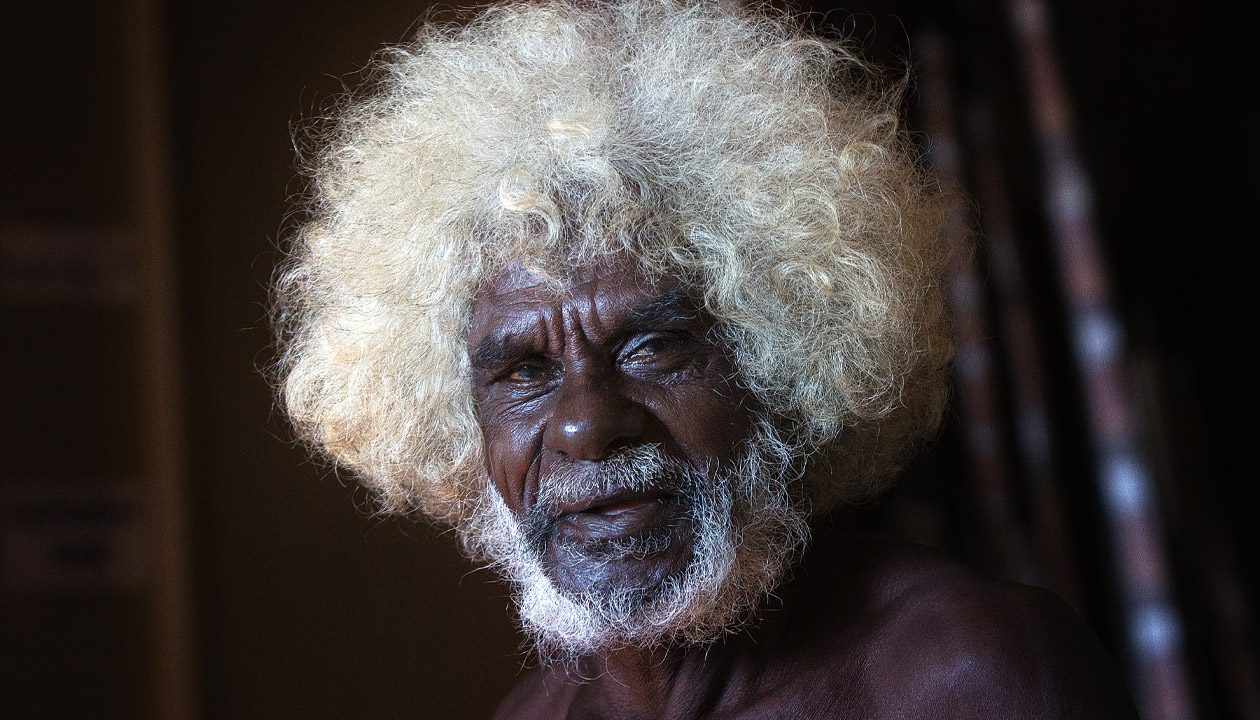Internationally recognised painter Balang John Mawurndjul belongs to an uninterrupted artistic tradition that is tens of thousands of years old.
Story + Photos David Hancock
Arnhem Land rock art provides the longest unbroken record of human culture found anywhere in the world, but to assume that these paintings of people, animals and spirits are purely manifestations from the past is to mistake the continuity of life itself. Those same images are propagated today among modern artists who may have changed the medium, but not the message. Their subjects remain part of their djang – their beliefs, cosmology, moral codes, sacred sites and, of course, their connection to country.
The djang of Balang John Mawurndjul, a Kuninjku speaker of the Kurulk clan, is centred around country near the outstations of Mumeka and Milmilngkan at the foot of the Arnhem Land plateau, some 50km south of Maningrida. “In my country or nearby I can go and see galleries painted by my ancestors, people I actually knew – my grandparents and other relatives,” he says. “Their paintings are there as a record and further back beyond them, generations and generations before them ... It is a significant treasure-house.”
John was born on his family’s traditional lands at Kubukkan in 1952 and had little contact with Europeans until his father, Anchor Kulunba, took him to Maningrida in the early 1960s suffering from leprosy. In time, John was healed and resumed the rhythm of life in the bush, travelling between camps as the seasons changed and learning important ceremonial duties. He started to paint in his late teens and developed an aptitude for rarrk – intricate cross-hatching. He was given responsibility to paint rarrk designs on the bodies of participants in important ceremonies.
John was surrounded by great artists of the day – Yirawala, Peter Marralwanga, Jimmy Midjawmidjaw, Wally Mandarrk and others, but was particularly influenced by his father Anchor and brother, Jimmy Njiminjuma. By the early 1980s, when John was expertly painting representations of the natural world, he started to incorporate rarrk into his work in a creative way, instead of using it as infill. This was a period when Indigenous people of Arnhem Land had few opportunities to earn income, except by creating art. Themes usually painted on rock and as body designs found their way onto bark.
During the 1980s and 1990s, Mawurndjul’s work formed part of travelling exhibitions from Arnhem Land. He started painting larger barks to create works that were both original and spectacular. Favoured subjects were ceremonies and beings such as Ngalyod, Nawarramulmul (Shooting Star Spirit) and Namarrkon/Ngalmarrkon (Lightning Spirit).
John won the Telstra National Aboriginal and Torres Strait Art Award for a painting on bark in 1999 and again in 2002 and 2016. He was awarded the prestigious Clemenger Contemporary Art Award at the National Gallery of Victoria in 2003 and, in 2005 and 2006, his work was shown in Paris and Basel, Switzerland.
In 2010, John was awarded a Member of the Order of Australia (AM) for services to the preservation of Indigenous culture as the foremost exponent of the rarrk visual art style. In 2018 he received the Red Ochre Award from the Australia Council for the Arts, for outstanding lifetime achievement. Also in 2018 the exhibition John Mawurndjul: I am the Old and the New showed at the Museum of Contemporary Art. It travelled to the Art Gallery of South Australia and a smaller version of the exhibition is currently touring in regional Australia until November 2020.
The full version of this story was published in both OUTBACK magazine and the 2019 edition of our special one-shot magazine Great Australians.
This story excerpt is from Issue #128
Outback Magazine: Dec/Jan 2020









